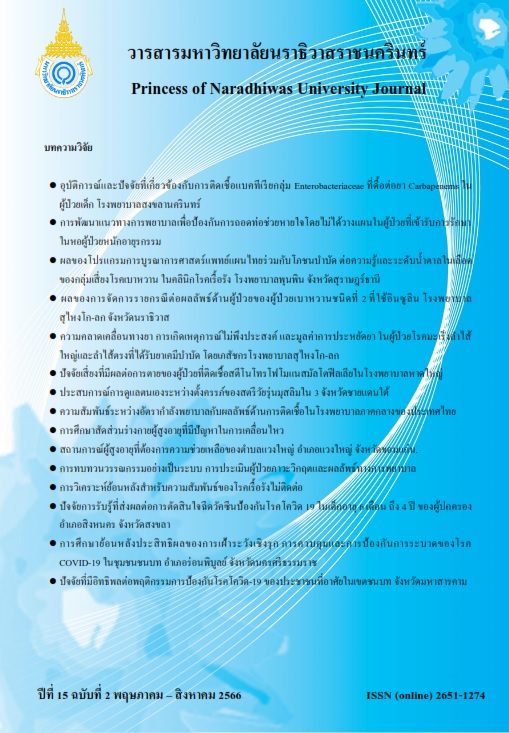Perceived Factors Affecting the Decision to Vaccination Against COVID-19 among Children aged 6 months to 4 years of Parents in Singhanakhon District, Songkhla Province
Keywords:
perception factors, decision to Vaccination, COVID-19 vaccineAbstract
The objectives of this research were 1) to study the perception factors of COVID-19 vaccination, 2) to study the decision to vaccinate against COVID-19, and 3) to study the perception factors of parents affecting the decision to vaccinate against COVID-19. The sample group was 172 parents, calculated by the G*Power program. The tool used was a questionnaire, received the IOC between 0.67-1.00 and the Cronbach's alpha coefficient. at 0.85. Data were analyzed by descriptive statistics: frequency, percentage, mean, standard deviation.
The analysis of cognitive factors affecting the decision to vaccinate against COVID-19 using step-by-step multiplicative regression showed as follows:
1. Factors of awareness of vaccination against COVID-19 in children aged 6 months to 4 years, the overview of each aspect and each item were at a high level.
2. The decision to vaccinate against COVID-19 in children aged 6 months to 4 years, the overview of each aspect and each item were at a high level.
3. Factors influencing the decision to vaccinate against COVID-19 were the perceived benefits of the vaccine (Beta=.358) and the safety and side effects of the vaccine (Beta=.176). The variance was 55.60% (adj.R2 = .556, p < .001), with a statistical significance at the .001 level and a standard error of prediction of .29396.
References
Best, J.W. (1971). Research in Education. New Jersey: Prentice Hall Inc
Chuenjai, K., & Punturaumpor, B. (2021). Factors affecting the decision to vaccinate against coronavirus (Covid-19) of the population in Bangkok. Retrieved October 20, 2022 from https://mmm.ru.ac.th/MMM/IS/twin9/6214154037.pdf
Cohen, J. (1988). Statistical power analysis for the behavioral sciences. Hillsdale, New Jersey:Lawrence Erlbaum Associates.
Faul, F., Erdfelder, E., Lang, A.G., & Buchner, A. (2007). G*Power 3: A flexible statistical power analysis program for the social, behavioral, and biomedical sciences. Behavior Research Methods, 39 (2), 175-191
Hair, J.F., Black, W.C., Babin, B.J. & Anderson, R.E. (2010). Multivariate Data Analysis (7th ed). New Jersey: Person Education
Phersriwatchara, E. (2022). Childhood infected with covid 19. Retrieved October 20, 2022 from https://workpointtoday.com/covid19-369/
Pobkeeree, V., & Thaweelap, S. (2019). Predictive factors associated with the acceptance of seasonal influenza vaccination for the elderly in Phra Phutthabat District, Saraburi Province, Disease Control Journal. 45(4), 418–430.
Sareera, S., LaksitanorL, P., & Limthai, S. (2000). Principles of Mardeting. Bangkok:Teera Film and Titex. (in Thai).
Srisa-Ard, B., & Nilkeaw, B. (1992). Statistical methode for research: (2 rd ed.) Suvireyasad, Bangkok. (in Thai).
Trakultaweesuk, P. (2021). Factors of influence Covid-19 vaccine Intent and vaccine’s concerns among hospital staff. Journal of Research and Health Innovation Development, 3: 47-57.
Turongsomboon,T. (2021). Condition mis-c in child. Retrieved October 20, 2022 from https://www. ram-hosp.co.th/news_detail/1660
Additional Files
Published
How to Cite
Issue
Section
License
Copyright (c) 2023 Princess of Naradhiwas University Journal

This work is licensed under a Creative Commons Attribution-NonCommercial-NoDerivatives 4.0 International License.




